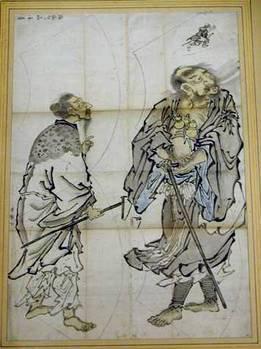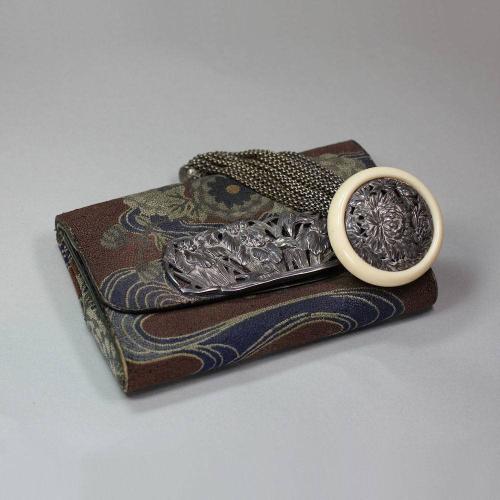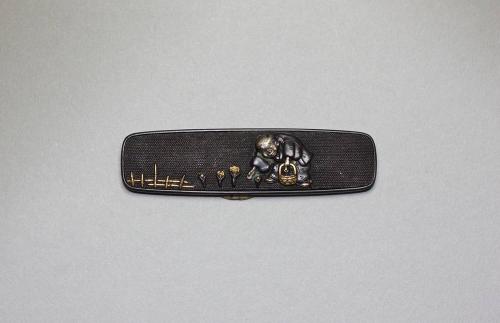
Price
£450.00This object is eligible for a Certificate of BADA Provenance
The BADA Standard
- Since 1918, BADA has been the leading association for the antiques and fine art trade
- Members are elected for their knowledge, integrity and quality of stock
- Our clients are protected by BADA’s code of conduct
- Our dealers’ membership is reviewed and renewed annually
- Bada.org is a non-profit site: clients deal directly with members and they pay no hidden fees
Japanese wood and lacquer mimidarai (耳盥) basin, Meji period (1868-1912), with tall foot and two applied trilobed ear-shaped handles, decorated in black lacquer and ‘maki-e’ gold, with a continuous design across the body and foot of clematis florida (Asian virginsbower) amongst tangled vines and foliage, the edges of the handles with a design of scrollwork in gold.
Dimensions:
Diameter including handles: 32.5cm. (12 3/4in.)
Condition:
See images
Notes:
Mimidarai (耳盥) is a type of lacquer bowl with distinct ear-shaped handles used as a utensil for tooth-blackening (ohaguro, お歯黒 ). Amongst other luxury lacquer items they were traditionally included in the bridal trousseaus of wealthy daughters of aristocrats or nobles. Though the practice of tooth-blackening declined in popularity during the Meiji period, prior to this it was common for young women to begin blackening their teeth after marriage. Black was a colour associated with beauty (it was favoured by the elite classes who also highly prized utensils made from black lacquer), and there is proof that the practice of coating the teeth in this manner also prevented tooth decay. The process was time-consuming, labour-intensive, and would need to be repeated frequently to maintain the desired black colour. It was achieved by dissolving iron filings in vinegar to produce a dark-brown solution of ferric acetate (kanemizu) before combining with vegetable tannins to produce a black liquid which could be painted onto the teeth, where it would harden into a black coating. An ohaguro utensil set would include a feather brush to apply the fluid to the teeth, a shozu bowl for the black solution, a fushibako box for tannin-rich gall powder from the Japanese sumac tree, a small porcelain bowl called an ugai-chawan for gargling after the process was finished, a watashigane tray used to hold all the separate utensils required, and a large mimidarai basin (over which this tray was balanced). This vessel would be filled with water for rinsing after applying the astringent solution, and for ensuring the black concoction does not stain anything other than the teeth. The basin’s tall foot meant that it could be used without having to bend over. A circa 1815 woodblock print by Utagawa Kunisada (1786-1865) from the series ‘three beauties making up their faces’ depicts a woman engaged in blackening her teeth; the utensils in the foreground include a black lacquer mimidarai basin, over which is balanced a watashigane tray and two other small vessels (‘shozu’ and ‘fushi-bako’, respectively) containing the black kanemizu solution and gall powder.
Given that the practice centred around the desirability and status of black lustre, the utensils used were commonly made out of black lacquer. Coloured lacquer is made by either adding a pigment composed of mercury sulphide to produce a vermilion shade, or iron (either the ‘togi’ residue left after sharpening a knife, or indeed the solution used in ohaguro) to produce a deep lustrous black. This example is decorated with gold maki-e, which would have been applied to the black lacquer while still wet. The design features flowering vines of clematis florida (テッセン), which was used as the exclusive family crest of the Nagai family (lords of the Setsu Takatsuki domain in present day Osaka Prefecture). It is possible that this mimidarai comprised part of a wedding trousseau for a women with links to the Nagai family.
Dimensions
Diameter including handles: 32.5cm. (12 3/4in.)Stock number
J584The BADA Standard
- Since 1918, BADA has been the leading association for the antiques and fine art trade
- Members are elected for their knowledge, integrity and quality of stock
- Our clients are protected by BADA’s code of conduct
- Our dealers’ membership is reviewed and renewed annually
- Bada.org is a non-profit site: clients deal directly with members and they pay no hidden fees




